 |
Euonymus atropurpureus
eastern wahoo
Deciduous shrub
Very unique fruit, with scarlet red berries emerging from bright pink capsules in late summer. Grows best in rich, moist, well-draining soil, in full sun to part shade. The foliage takes on a bright red color in fall.
|
 |
Ilex decidua
possumhaw
Deciduous shrub
A deciduous holly with small, inconspicuous white flowers in the summer that become bright red berries. The berries will remain on the plant into the winter and are enjoyed by birds. Adapts well in most soils, but prefers moist, well-draining conditions in full sun to part shade.
|
|

|
Staphylea trifolia
bladdernut
Deciduous shrub
The native bladdernut is a clump forming shrub or small tree found in moist, woody areas. Can be used in the landscape to make an informal hedge in a naturalized area. The white, pendulous flowers and bladder-like seeds are showy, but this plant may not be suited for urban landscapes.
|
|

|
Viburnum prunifolium
blackhaw viburnum
Deciduous shrub
Native understory tree able to adapt to somewhat dry soil once established. It prefers well-draining conditions in part shade. Clusters of white flowers are followed by blue-black, berry like drupes which are eaten by birds into the winter. The fall foliage is very showy, turning shades of red and purple. Slow-growing.
|
|

|
Juniperus virginiana
red cedar
Needled evergreen
Very adaptable to a wide range of soils and growing conditions but is intolerant of poorly-draining soils. Cultivars of this Missouri native come in all sizes and can add interest to the winter landscape.
|
|

|
Pinus echinata
short-leaf pine
Needled evergreen
This pine was once more widespread in Missouri, but today is found mostly in the protected areas of the Ozarks. Does best in well-draining, sandy loam soil but can tolerate a wide range of conditions. Plant in full sun. The long taproot can make transplanting older trees a challenge.
|
|

|
Acer rubrum
red maple
Tree
This soft maple’s wood is stronger than the silver maple but not as tough as the hard sugar maple. It has a relatively fast growth rate and the orange to red autumn color is dependable. Can tolerate a variety of soils, but prefers moist, well-draining, slightly acidic conditions. Very common street or lawn tree. Many cultivars are available.
|
|

|
Acer saccharum
sugar maple
Tree
Best grown in moist, well-draining soils in full sun to part shade. Generally intolerant of road salt, urban pollution, and compacted or poorly drained soils. In the proper location, this tree offers reliable, yellow-orange fall color, and its hard wood is resistant to breakage. Maple syrup is made from the sap of the sugar maple tree.
|
|

|
Aesculus glabra
Ohio buckeye
Tree
Grows easily in average, well-drained soils in full sun to part shade, and produces many notable flowers clusters in spring. Fall color is minimal, and the leaves usually start to brown and discolor in the heat of late summer. The large, round fruits yield slick, shiny nuts which give the tree its common name. Can be a large, messy tree and is not well suited for use as a street tree.
|
|

|
Asimina triloba
pawpaw
Tree
Will form colonies from underground spreading rhizomes over time. Unique, edible fruits. This understory tree will tolerate part shade, but the densest growth and best fruiting occur in full sun. However, the fruits attract squirrels and raccoons, so keep this in mind if planting in a populated area.
|
|

|
Betula nigra
river birch
Tree
This fast-growing, usually multi-trunk trees has thin, spreading branches. Peeling bark is showy all year round. Disease resistant and well adapted to Missouri’s hot, humid summers, this tree can become quite large. Can tolerate heavy, clay soil, but best growth is seen in very moist, slightly acidic soil. In alkaline conditions, can develop iron chlorosis.
|
|

|
Carpinus caroliniana
American hornbeam
Tree
The smooth, sinuous bark of this understory tree is very distinct. American hornbeam is found along rocky stream banks and moist, wooded areas of Missouri. Prefers moist soils with plenty of organic matter. Three-lobed fruiting structures drooping from the tree are showy, and the fall color can include shades of yellow, orange, and red.
|
|

|
Carya illinoinensis
hardy pecan
Tree
A very large tree with a wide, spreading canopy. It produces edible fruits and takes on a bright, golden yellow fall color. Best sited in a large, open area with rich, moist, well-draining soils. If growing for nut production, plant different cultivars to increase cross-pollination.
|
|
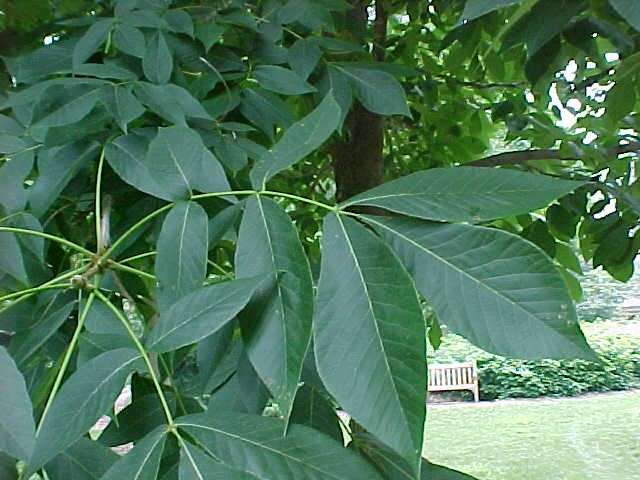
|
Carya laciniosa
shellbark hickory
Tree
Found in wet bottomland areas in the wild. Best sited in a large, open area with rich, moist, well-draining soils. Can produce large amounts of twig and fruit litter and reaches considerable heights. Not recommended as an urban street tree.
|
|

|
Catalpa speciosa
catalpa
Tree
Widely planted in urban areas, this large tree can be easily grown in a range of soil conditions, but prefers moist, well-draining soils. Large, white flower clusters are attractive and are followed by long, hanging seed pods. Seedlings appear in roadsides and disturbed sites. Can mature into a symmetrical, rounded shape, but are more likely to take on a coarse, undistinguished form.
|
|

|
Celtis laevigata
sugarberry
Tree
A close relative of hackberry though more common in the southern US. Appearance is also similar to hackberry, although it lacks the warty bark, and leaf margins are less serrated. Tolerates wind and urban conditions. Prefers moist, well-draining soils in full sun, but will adapt to many soil types.
|
|
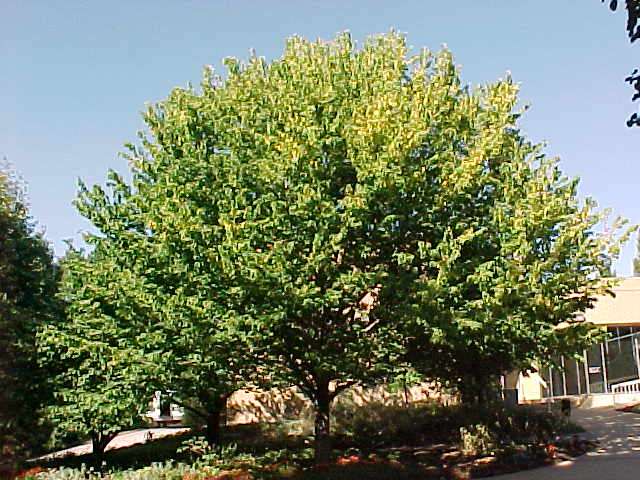
|
Celtis occidentalis
hackberry
Tree
An adaptable tree, hackberry will tolerate a wide range of soil conditions, as well as windy and polluted urban environments. Best growth is in full sun with rich, well-draining soils. It has good natural form and interesting warty bark. The wood is strong, and the tree has few serious pests, though harmless leaf galls are common.
|
|

|
Chionanthus virginicus
fringe tree
Tree
A beautiful small tree. The delicate ‘strap-like’ petals of the native fringe tree hang from the ends of stout branches in mid to late spring. In fall, clusters of berry-like drupes ripen to dark blue-purple and are loved by birds. Will tolerate a wide range of soil conditions, including clay, but prefers well-draining, moist, fertile soils. Does well in urban environments but will not tolerate prolonged drought.
|
|

|
Cladrastis kentukea
yellowwood
Tree
A medium-sized tree, best sited in semi-dry locations protected from strong winds. The dangling clusters of fragrant, white flowers are showy, though new trees may take several years before blooming. Fall color is a bright yellow. More hardy in southern regions, this tree can adapt to colder climates but will not grow as large.
|
|

|
Cornus florida
flowering dogwood
Tree
The state tree of Missouri. In the wild it is found at forest edges and as a small, understory tree. Will tolerate a range of soil conditions, but prefers organically rich, slightly acidic, well-drained soils in full sun to part shade. When stressed, can become susceptible to several pests and diseases. Many cultivars are available which tout superior disease resistance and more profuse, colorful blooming.
|
|
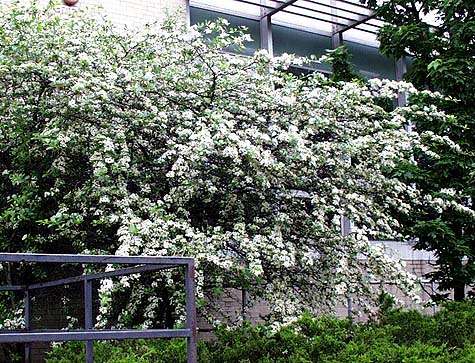
|
Crataegus crus-galli
cockspur thorn
Tree
Can be grown as a solitary tree or massed into a large hedge or screen. Well-draining soil is key, but otherwise can tolerate a range of environmental conditions. White blossoms in spring give way to small berries, which ripen to deep red, persisting on the tree into late fall. Stems are considerably thorny. Susceptible to various pests and diseases of hawthorns, including rusts, leaf spots, apple scab, and blights.
|
|

|
Crataegus phaenopyrum
Washington hawthorn
Tree
Best grown in moist, well-draining soils in full sun. Will tolerate light shade. Stems are thorny. White flowers in spring and red fruits in fall are showy. This species has good resistance to rusts and is somewhat resistant to other common hawthorn diseases.
|
|
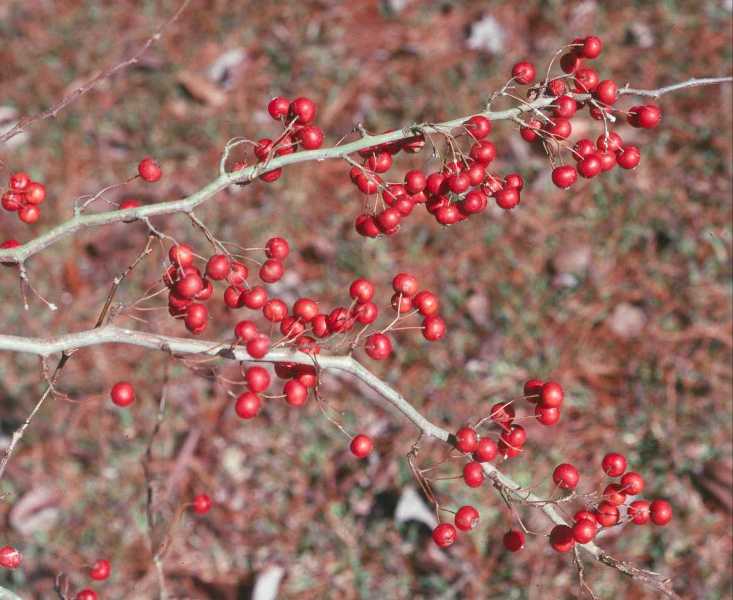
|
Crataegus viridis
green hawthorn
Tree
Does best in moist, well-drained soils in full sun to part shade. Once established will tolerate drought. Will also tolerate urban conditions. Has the best disease resistance of all the native hawthorns. The bark and fruit are attractive through winter. Generally free of thorns. Cultivars are available, including ‘Winter King’.
|
|
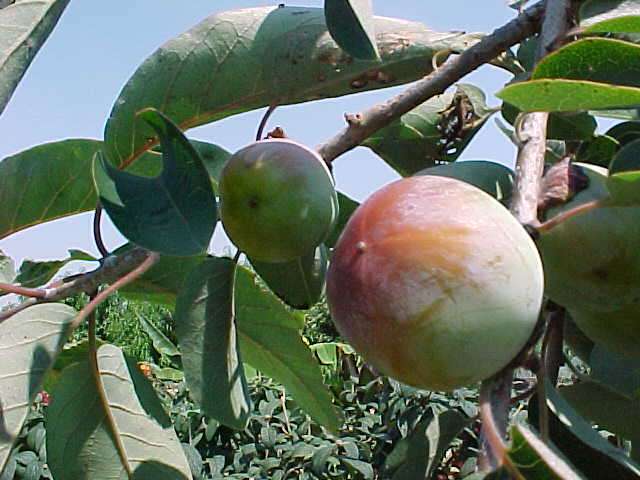
|
Diospyros virginiana
persimmon
Tree
Persimmon trees bear round, orange, edible fruits. They are also notable for their straight form and dark, scaly bark. The wood of this ebony relative is very hard. Can adapt to a range of soil conditions, but does best in sandy, well-draining soil in full sun to part shade.
|
|
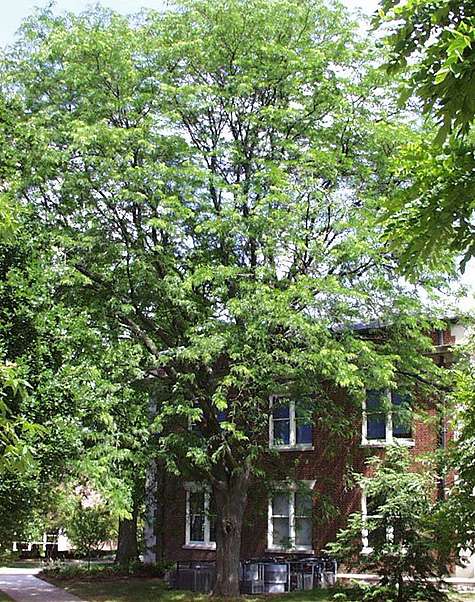
|
Gleditsia triacanthos
honey locust
Tree
Very tolerant of all soil types. Also tolerant of wind, summer heat, drought, and salt spray. The leaves turn a golden yellow color in fall and break down quickly. However, the straight species is not recommended for any street or garden. The branches are covered in sharp thorns, and the seed pods are numerous and messy. Plant only seedless and thornless cultivars, such as ‘Skycole’.
|
|

|
Gymnocladus dioica
Kentucky coffee tree
Tree
Kentucky coffee tree is a large, unique species native to the Midwest. The bark is dark and deeply ridged. The large, compound leaves are attached to thick branches. The roasted seeds were utilized by native Americans and early European settlers for food. Can adapt to urban conditions, but clay soils should be avoided. Prefers rich, well-draining soils in full sun.
|
|
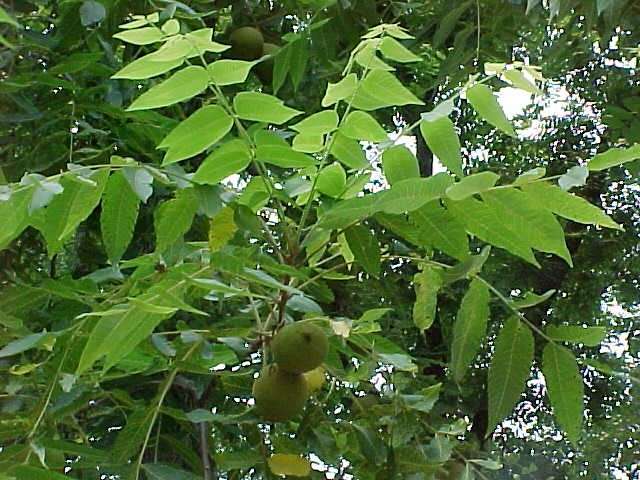
|
Juglans nigra
black walnut
Tree
Prefers rich, well-draining soils in full sun. Will not tolerate shade. The fruits are edible but harvesting and cleaning the large seeds is messy work. Overharvesting of wild populations for wood has reduced their numbers. The tree has an interesting branching pattern, best seen in winter.
|
|

|
Liquidambar styraciflua
sweet gum
Tree
Sweet gums have excellent fall color. A single tree can have shades of yellow, orange, red, and purple all at once. They are also generally easy to grow in average, well-draining soils in full sun. However, the spherical, hard, bristly fruiting structures (known as gum balls) are a hassle to deal with. They decompose slowly and can present a slip hazard on sidewalks.
|
|

|
Liriodendron tulipifera
tulip tree
Tree
This fast-growing tree can reach 90’ tall. It’s beautiful cup-shaped flowers and yellow fall color add to the appeal. But the tulip tree’s fast rate of growth can create weak wood. They can also be susceptible to scale and aphids, sap-sucking insects which cause honeydew secretions to accumulate on cars, sidewalks, and leaves. Best sited in well-draining, rich soil in full sun away from buildings and streets. Offers great pollinator benefits.
|
|

|
Magnolia acuminata
cucumber tree
Tree
The only magnolia native to Missouri, it is found in the far southern counties along the Mississippi River in moist, wooded valleys and the bases of bluffs. A deciduous magnolia named for green fruits which follow the yellow-green flowers. Can reach 70’ tall and requires well-drained, loamy soil in full sun to part shade.
|
|
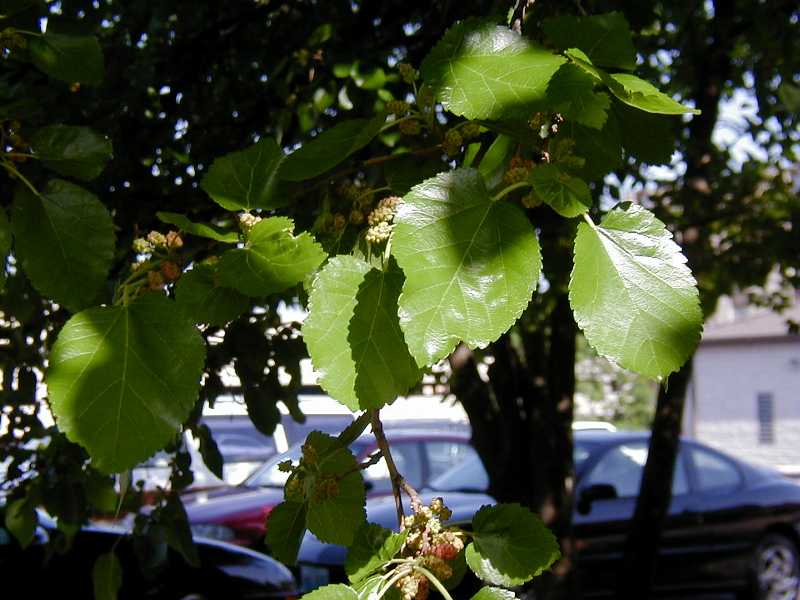
|
Morus rubra
red mulberry
Tree
A native fruit tree with positive and negative aspects. Easy to grow in almost any soil type, the bright red berries are sweet and beloved by humans, birds, and other wildlife. However, these traits also mean it will seed prolifically in the garden, sending down a long, yellow taproot deep into the soil. The fruits can also stain shoes, carpet, cars, and sidewalks. There are male cultivars available which avoid these pitfalls, since the males do not produce fruit, but the wildlife and foraging benefits of having the fruits are then lost.
|
|

|
Nyssa sylvatica
black gum
Tree
One of the best native trees for reliable, red fall color. Grown best in moist to wet soils in full sun to part shade. Tolerates poorly-drained soils. The insignificant flowers offer pollinator benefits, and the small, dark fruits offer wildlife benefits. Few disease problems. An all-around excellent choice for the home gardener and becoming easier to find at nurseries.
|
|
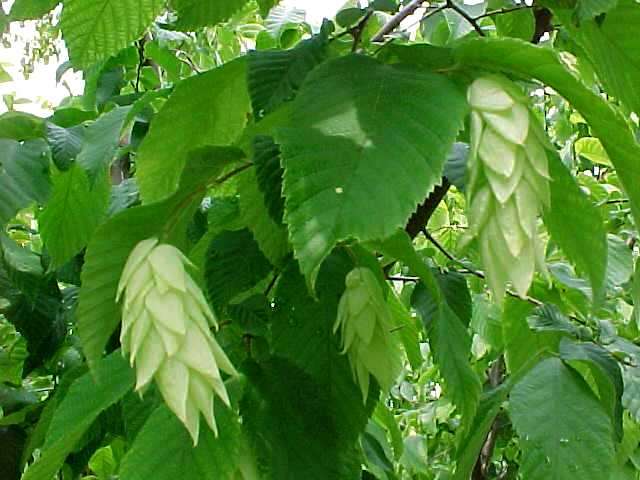
|
Ostrya virginiana
eastern hop hornbeam
Tree
An understory tree reaching 40’ tall. Best grown in well-draining soils in full sun to part shade. Can adapt well to urban conditions. Also known as ironwood, in reference to its hard, dense wood.
|
|
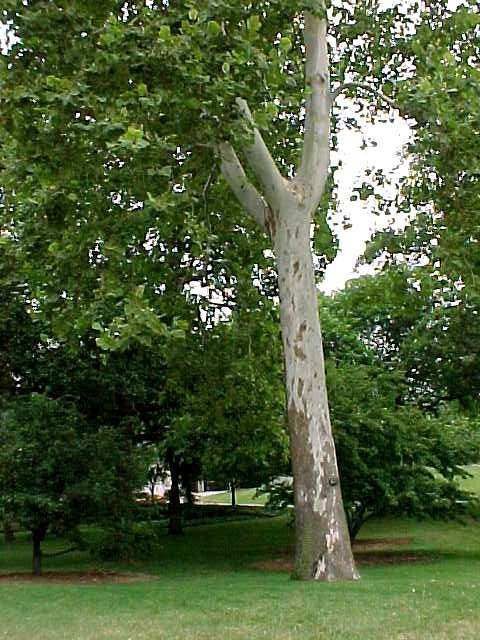
|
Platanus occidentalis
American sycamore
Tree
Generally considered to be the largest tree native to eastern North America, reaching 100’ tall and 8’ in diameter. The exfoliating bark is showy. Sycamore anthracnose (a fungal disease) can disrupt bud and leaf formation, but on its own is not usually fatal. Fruit, twig, and leaf drop make this tree not well suited to urban plantings. Best sited in a large, open area with moist, well-draining soils.
|
|

|
Populus deltoides
eastern cottonwood
Tree
A large, fast-growing tree that is easy to grow in moist to wet, well-draining soils in full sun. Not appropriate for use as a street tree or near the home, since its fast growth rate leads to weak wood and branch breakage. The fluffy seeds can also cause cleanup issues in gutters and air conditioning filters. A good choice for a low, wet, open area away from homes and streets.
|
|
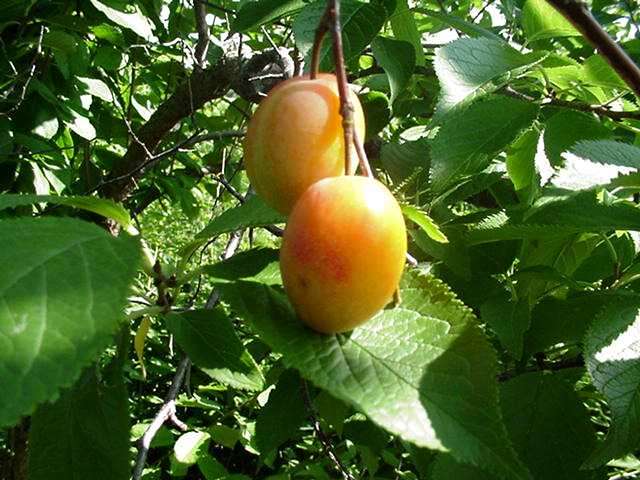
|
Prunus americana
wild plum
Tree
A small tree or multi-stemmed shrub. Can tolerate a range of soil conditions as long as full sun is provided. White spring blooms are followed by 1” diameter round fruits. Fruits are edible, but not particularly tasty. Branches and twigs can be quite thorny. Suckers freely and is best suited for use in a naturalized area, as a hedge or screen.
|
|

|
Prunus serotina
black cherry
Tree
The most widespread of our native cherries, this tree can reach 80’ in height. Clusters of white flowers bloom in late spring and are followed by small red fruits. Though edible, they are quite bitter, and are favored by birds. The wood has high commercial value for use in furniture, cabinets, and other products. Best grown in fertile, well-draining soils in full sun. Even in ideal conditions, it is still susceptible to many pests and diseases.
|
|

|
Quercus alba
white oak
Tree
A slow-growing, impressive specimen tree. Can adapt to a wide range of soils, but prefers well-draining, moist, and slightly acidic conditions in full sun. Fall color is variable and can range from brown to scarlet red. The white oak group is characterized by rounded leaf lobes, and good resistance to oak wilt, leaf spot and other diseases affecting oaks.
|
|

|
Quercus bicolor
swamp white oak
Tree
A good choice for compacted, urban soils. Can tolerate wet conditions but prefers acidic soils. When soils are alkaline, it can cause leaf chlorosis (yellowing of the leaf tissue between the veins). Can reach 60’ tall and is generally free of the pests and diseases of other oaks. Transplant when young.
|
|
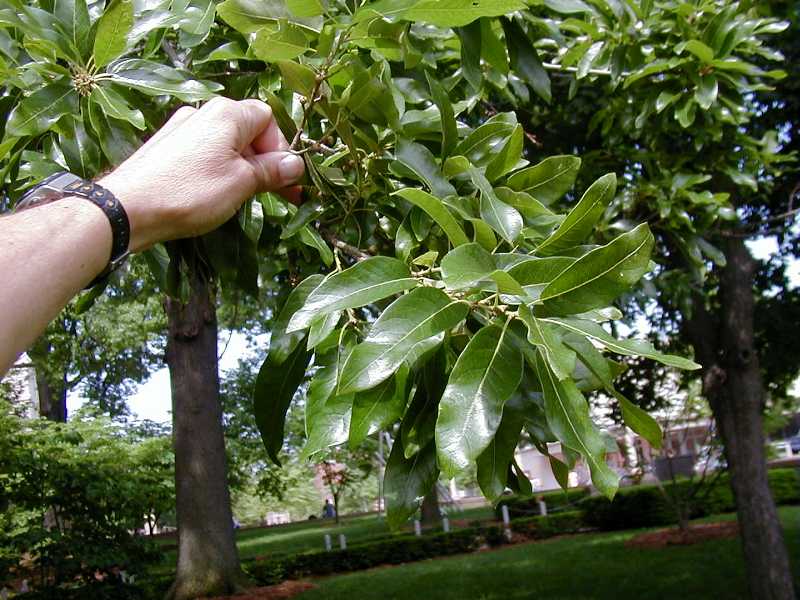
|
Quercus imbricaria
shingle oak
Tree
Grows well in rich, well-draining soils in full sun. Can adapt to other soils, include semi-dry. Leaves are narrow and unlobed. Can suffer from various pests and diseases common to oaks but is generally considered to be low maintenance and long-lived.
|
|

|
Quercus macrocarpa
bur oak
Tree
Can adapt to a variety of soils in full sun, but prefers moist, well-draining conditions. Can tolerate some drought once established. Matures into a majestic specimen tree with a wide, spreading crown. Can suffer from various pests and diseases common to oaks but is generally considered to be low maintenance and long-lived.
|
|

|
Quercus phellos
willow oak
Tree
A faster growing oak that is tolerant of many different soil types and urban pollution. Grows best in well-drained, loamy soils in full sun. The leaves are narrow like those of willows. Can suffer from various pests and diseases common to oaks but is generally considered to be low maintenance and long-lived.
|
|

|
Quercus rubra
red oak
Tree
Prefers acidic, fertile, well-draining soils in full sun. Has a moderate to fast growth rate and can reach 75’ tall. Can suffer from various pests and diseases common to oaks but is generally considered to be low maintenance and long-lived.
|
|
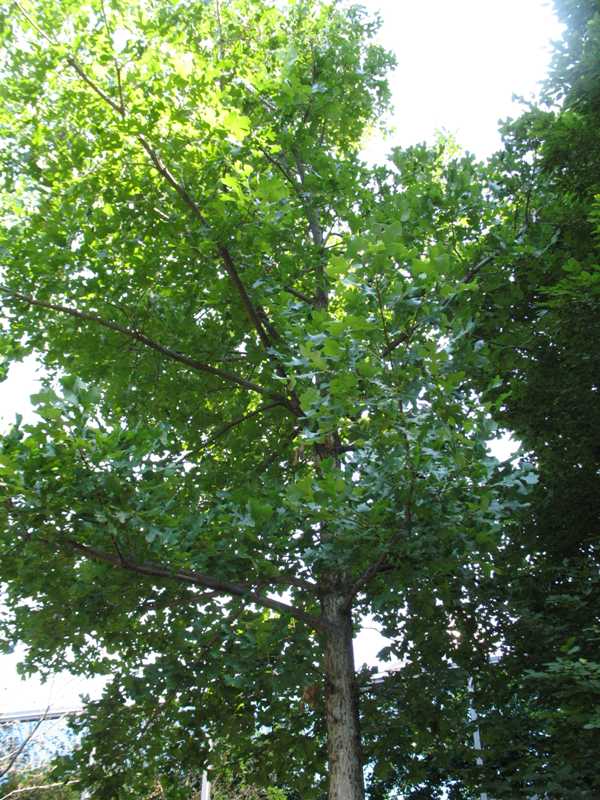
|
Quercus stellata
post oak
Tree
Can adapt to variety of soil types, from poor, dry, sandy soils to moist, heavy loams. Prefers acidic soil. Slow growth rate, but strong, dense wood. Can suffer from various pests and diseases common to oaks but is generally considered to be low maintenance and long-lived.
|
|

|
Sassafras albidum
sassafras
Tree
One of the best trees for fall color. Plant in full sun to part shade, with medium moisture, well-draining soils. A deep taproot makes them tolerant of drought, but difficult to transplant. Watch for suckers and seedlings. The bark and roots of sassafras have been used culinarily in the past, but the oils are now known to be toxic.
|
|
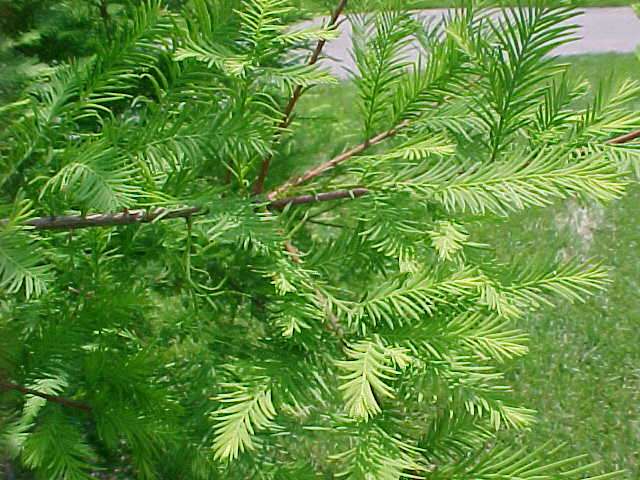
|
Taxodium distichum var. distichum
bald cypress
Tree
A tough tree, well suited for harsh environments. In the wild can be found growing in standing water or along river banks. In a garden setting, does just as well in well-draining conditions. Tolerates urban pollutants and compacted soils. The soft, feathery foliage turns coppery-orange in the fall and is shed from the tree. The round, 1” diameter cones decompose quickly. The wood is strong and resistant to rot.
|
|

|
Tilia americana
American linden
Tree
A strong, relatively disease-free shade tree. Can reach 80’ tall. Best grown in medium moisture, well-draining soils in full sun to part shade. This tree is intolerant of air pollution, compacted, poor soils, and urban conditions.
|